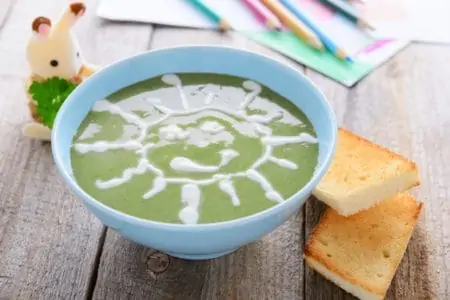The dinner table standoff is a classic parenting rite of passage. You prepared a healthy meal, but your toddler looks at a piece of broccoli like it’s an alien life form. Health authorities recommend consuming at least 5 fruits and vegetables daily (1), but getting a stubborn two-year-old to comply is a different story.
So, how do you win the battle without the tears?
We poured hours into research to find tried-and-true methods for getting toddlers to eat vegetables. With the right approach (and a little patience), you can actually enjoy mealtime again. plus, we are sharing 10 veggie-packed recipes to test your new tactics.
Key Takeaways
- Taste Matters: Toddlers often reject vegetables due to biological sensitivity to bitter flavors and texture issues.
- Stealth Mode: Sneak nutrients into meals by pureeing veggies into sauces, smoothies, and baked goods.
- Get Involved: Kids are more likely to eat what they help create, so involve them in shopping and cooking.
- Consistency is Key: It can take up to 15 exposures for a child to accept a new food, so don’t give up.
Why Don’t Toddlers Like Vegetables?
Understanding the “why” behind the refusal can help you keep your cool. When infants start solids between 4 and 6 months, they usually accept purees easily. However, as they transition to table foods, their growth slows down, and their appetite often decreases.
It’s easy to blame your cooking, but biology plays a role. Toddlers have more taste buds than adults, making them highly sensitive to bitter flavors found in many greens. Additionally, the sugar, salt, and fat found in processed toddler foods can create a preference for hyper-palatable snacks over subtle natural flavors.
Furthermore, food marketing promoting “kid-friendly” nuggets and fries makes a plain carrot seem pretty boring (2).
Here are proven strategies to expand your toddler’s palate beyond the “beige food” trifecta of macaroni, pizza, and nuggets.
How to Get a Toddler to Eat Vegetables
1. Sneaky Vegetables
Hiding the vegetables might feel like cheating, but it is a smart way to ensure nutrient intake during picky phases. Purees are your best friend here.
- Watch the Colors: If you are nervous about detection, blend white or orange vegetables like yellow squash or cauliflower into mac and cheese. It keeps the cheesy appearance and adds a creamy texture.
- Meat Dishes: When making lasagna or meatballs, mix in shredded carrots, beets, or zucchini. This increases moisture and flavor while hiding the greens. For soups, blend the vegetables into the broth if your child picks around chunks.
- Green Eggs: Make breakfast fun by recreating “Green Eggs and Ham.” Simply puree steamed broccoli or spinach and scramble it right into the eggs.
I recommend this technique to many of my parents. Tomato sauce, for example, is a great way to hide cooked veggies. Just add them to a blender with your sauce of choice, then heat it. This sauce can be used on pasta for toddlers who are willing to eat “red” sauce or as a pizza sauce added to prepared pizza dough. Either way, your child will get a few portions of vegetables.
Editor's Note:
Dr. Leah Alexander, MD, FAAP2. Make It Sweet
Vegetables work surprisingly well in baked goods. Zucchini in chocolate cake is delicious, moist, and subtle enough that your toddler won’t notice it.
- Cookies: For a nutrient boost, replace some butter in your cookie dough with white-bean puree or mashed bananas. You can even add pureed spinach to brownies (you can’t taste it, we promise).
- Batters: Add beets to chocolate cakes for richness, or mix carrots and squash into yellow cakes. During autumn, pumpkin pancakes are always a hit. Just remember to pair light vegetables with light-colored batters to avoid suspicion.
3. Smart Substitutions
If you can’t sneak the veggies in, try swapping the main ingredients entirely.
- Veggie Burgers: These are excellent substitutes for beef patties. You can mask the veggie taste with cheese and a bun. If buying frozen, check the label for simple, whole-food ingredients to avoid heavy processing (3).
- Spaghetti Squash: This is a game-changer for pasta lovers. Once cooked and scraped, it resembles noodles. Cover it with a robust marinara and parmesan, and many toddlers won’t know the difference.
- Tacos: Texture is key with tacos. Instead of ground beef, try veggie crumbles or finely chopped mushrooms and walnuts. Buried under sour cream and cheese, it’s a veggie victory.
4. Juice and Smoothies
A simple way to make vegetables approachable is by blending them into a toddler-friendly smoothie. Mixing spinach with high-flavor fruits masks the vegetable taste completely. Unlike juicing, smoothies retain the fiber, which is crucial for digestion.
- Ice Pops: Pour your green smoothie into molds to create “monster pops.” Everything is more exciting when it’s a frozen treat.
- The Golden Ratio: Start with more fruit and less veggie. Bananas, grapes, and pineapple are strong maskers. As they get used to it, slowly increase the greens.
There are many prepared blended juices and smoothies available on the market, something very convenient for busy parents. However, some contain added sugar, so it is important to check the nutrition label.
Also, I have some parents who use bottled fruit juice to make veggie smoothies for their children. Unfortunately, such juices contain lots of sugar, this making the smoothie unhealthy (4). I recommend using coconut water instead which also gives added potassium.
Editor's Note:
Dr. Leah Alexander, MD, FAAPBaby Under 12 Months?
5. Gamify Mealtime
Instead of using force, try fun. Toddlers respond well to games, which can lower their defenses around new foods (6).
Sit down with your toddler and sort vegetables by color. Ask them, “Which color should we eat for super strength today?” The rule is that the chosen color must end up on both of your plates.
You can also let them “decorate” their pizza or tacos. Giving them autonomy creates a sense of ownership, transforming them from passive eaters to active participants.
6. Include Them in the Kitchen
Our little one despised vegetables until he began helping out in the kitchen. Including him in the process was the turning point. When kids touch, smell, and handle raw veggies without the pressure to eat them immediately, they become less scary.
Start by creating a safe workspace. You can buy nylon knives that cut food but not skin. Choose a few vegetables and let them wash or chop.
While the food cooks, give them a “tasting job.” Ask, “Does this need more salt?” or “Is this crunchy?” By the time dinner is served, they are often excited to eat what they made.
Some of my patients love a particular condiment or seasoning. Ketchup seems to be a favorite. My recommendation to parents is that if their child will eat the vegetables when ketchup is added, then go ahead and use it.
Editor's Note:
Dr. Leah Alexander, MD, FAAP7. Teach Them About Produce
For older toddlers, turn the grocery store into a classroom. Spark their curiosity by explaining how potatoes grow underground like buried treasure, or how broccoli looks like tiny trees.
Explain the “superpowers” of different foods. For example, tell them orange carrots help them see in the dark (mostly true!), or red peppers help their heart (7). If you have the space, planting a simple container garden with cherry tomatoes can work wonders for interest levels.
8. The Power of Dip
A tasty hummus dip is a staple at our table. Toddlers love the mechanical action of dipping, it makes eating interactive and gives them control over the flavor ratio.
Rotate your options to keep it fresh. Try guacamole, mild salsa, ranch, or even Greek yogurt. If the broccoli is just a vehicle for the ranch dressing, that is still a win.
9. Focus on Visual Appeal
We eat with our eyes first (8). While adults might appreciate a neat salad, toddlers love whimsy. Use cookie cutters to turn cucumbers into stars or bell peppers into dinosaurs. Arrange veggies on the plate to look like a face or a scene. It takes an extra two minutes but can save twenty minutes of negotiating.
10. Serve Courses
Our toddler used to fill up on bread and pasta, pushing the green beans aside. To combat this, try serving courses.
Offer a “veggie appetizer” when they are hungriest. Put out a plate of colorful peppers, cucumbers, and snap peas while you finish cooking the main dish. With no other options competing for attention, they are much more likely to munch on the fresh produce.
11. Lead by Example
Children are observant little mimics. If you heap veggies onto your plate and express how delicious they are, your child is more likely to follow suit. Conversely, if you talk about “dieting” or eating salads as a chore, they will pick up on that negativity. Make veggies a normal, enjoyable part of the family meal (9).
12. Rethink Supplemental Drinks
Many parents rely on toddler formulas or supplemental shakes to bridge nutritional gaps. However, these sweet drinks can backfire.
They are often filling and high in sugar, which kills the appetite for real food. If a child knows they will get a sweet shake if they refuse dinner, they have no incentive to try the broccoli. Major health organizations like the AAP advise against routine toddler formulas for most healthy children (10).
13. The “Don’t Give Up” Rule
This is scientifically known as “repeated exposure.” Research shows a child may need to taste a new food 10 to 15 times before they accept it.
If they spit out asparagus today, don’t label them as “someone who hates asparagus.” Just try again in a few days, perhaps prepared differently (roasted instead of steamed). Keep the mood neutral and don’t pressure them. Exposure creates familiarity, and familiarity eventually breeds acceptance.
Ten Toddler-Friendly Vegetable Recipes
1. Parmesan Zucchini Tots
Crispy, cheesy, and dippable. These Parmesan zucchini tots are a fantastic alternative to potato tots. While they are packed with zucchini, your toddler will mostly taste the cheese and the crunch. Serve them with a side of marina or ketchup for maximum dipping fun.
2. Colorful Rainbow Fritters
Toddlers are drawn to bright colors, and these fritters deliver. They are essentially savory pancakes packed with peppers, zucchini, corn, and carrots. They are easy to hold for small hands and freeze beautifully for quick lunches.
3. Broccoli Cheddar Quinoa Cups
These mini bites are a protein-packed finger food. The cheddar cheese provides a bridge flavor that makes the broccoli more palatable. They are perfect for lunchboxes or on-the-go snacking.
4. Hidden Veggie Power Popsicles
Who says veggies can’t be dessert? These popsicles are bursting with carrots and spinach, masked by the sweetness of mangoes, oranges, and pineapple. It is a hydrating, guilt-free treat for hot days.
5. Creamy Butternut Mac and Cheese
This recipe uses a clever trick: blending butternut squash and carrots into the cheese sauce. It deepens the orange color and adds a natural sweetness that complements the cheddar perfectly. It is the ultimate comfort food hack.
6. Chocolate Peanut Butter Veggie Muffins
Peanut butter and chocolate are a powerful duo for masking flavors. These muffins use grated carrots and sweet potatoes to keep the crumb moist and fluffy. Your toddler will think they are getting a decadent treat, but you will know they are getting a dose of Vitamin A.
7. Green Monster Spinach Muffins
Lean into the “Hulk” or “Monster” theme with these bright green muffins. The color comes entirely from fresh spinach blended into the batter. With bananas and vanilla extract, they taste sweet and fruity, not leafy.
8. Supercharged Veggie Chili
Chili is a forgiving dish that can hide a multitude of vegetables. This recipe incorporates zucchini, eggplant, peppers, and onions, all simmered down until soft and flavorful. The texture is consistent, which helps with toddlers who dislike “chunks.”
9. Ultimate Hidden Vegetable Lasagna
Lasagna is already a kid favorite, so why not boost it? This version layers in carrots, mushrooms, cauliflower, and spinach. The cheese and pasta sheets provide a familiar texture, making the veggies much less intimidating.
10. Veggie-Boosted Meatballs
Meatballs are fun to eat and easy to modify. Grate carrots or zucchini finely and mix them into your ground meat. They add moisture, preventing the meatballs from drying out, while adding a nutritional punch.
How Much Should Toddlers Eat?
It is easy to overestimate how much food a small child needs. Toddler stomachs are small, about the size of their fist.
A general rule of thumb for vegetables is 1 tablespoon per year of age, per meal. So, a two-year-old might only need two tablespoons of carrots at dinner.
Daily caloric needs are roughly 40 calories for every inch of height (11). Don’t stress if they eat a lot one day and nothing the next; look at their intake over the course of a week rather than a single day.














